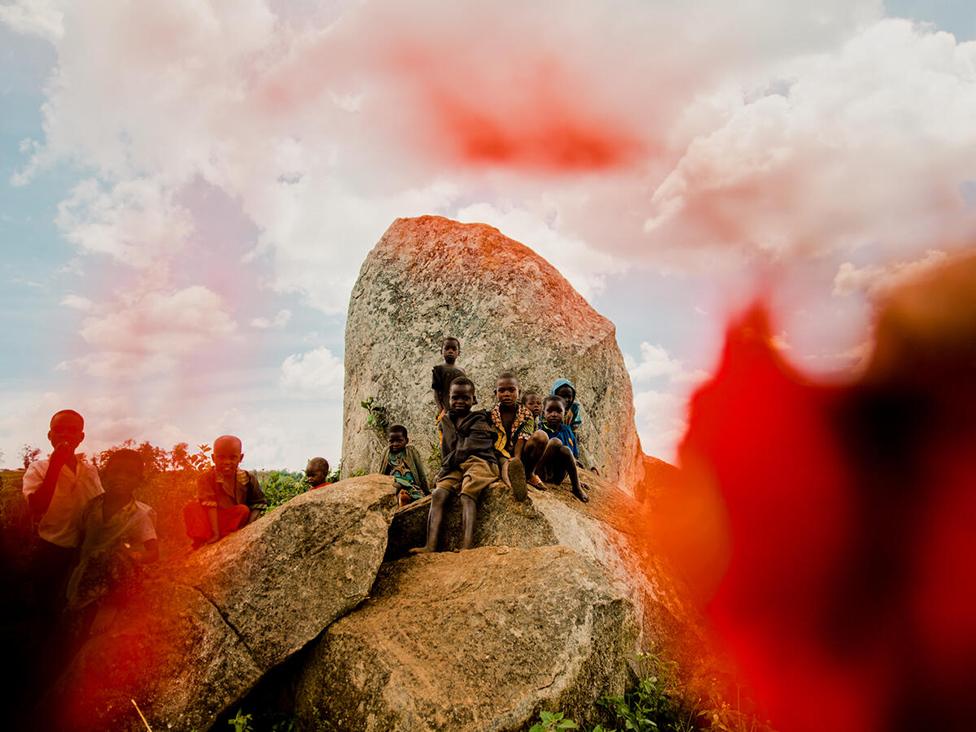Inner Light: The children surviving conflict in DR Congo
- Published

Photographer Hugh Kinsella Cunningham has travelled across the north-eastern province of Ituri in the Democratic Republic of Congo, with Save the Children, to document the personal stories of children caught up in conflict.
The recent history of DR Congo has been one of civil war and corruption that has claimed hundreds of thousands lives, either as a direct result of fighting or because of disease and malnutrition.
Violence now involves myriad armed groups challenging the authorities and often targeting civilians.
Cunningham aims to create a sense of hope with his use of colour in his portraits. Each subject is photographed without digital manipulation, using flowers and objects found in the camps for displaced people, carefully positioned in front of the lens.
Everything changed for 12-year-old Veronique when armed groups attacked her village, forcing her family to flee to a nearby camp for internally displaced people (IDP).
"When we were still in our village, we led a good and normal life. My parents could work in the fields and buy us clothes," says Veronique. "But since I arrived here at the site, everything has become problematic."
"I wanted to continue my studies, because I was in my fourth year, but now there is no way, due to lack of resources."
"On the road I saw attackers kill, cut throats, shoot weapons and steal clothes," says Emilie, 15.
Emilie and her family were chased by armed soldiers to a nearby forest where they managed to hide. The family now lives in a camp hosting thousands of families and children who have fled the violence.
"Here we don't have enough food to eat," she says. "When I was in the village, I ate food from the field, but here we have nothing."
David, 12, was in his fifth year at school when he fled from his home because of conflict.
"When we fled we saw dead bodies on the ground, including some friends who were killed," he recalls.
Although life is safer here, he sleeps with little protection against the cold nights, and longs for peace so that he can return home.
Access to water, protection from the elements, and basic nutrition and hygiene are all critical issues for the displaced people in the camps. Health services are limited.
A Save the Children project aims to provide health, nutrition, and protection. Psychological support is also provided for victims of sexual and gender-based violence as well as for children who have been separated from their parents.
Even though he is now safe from the violence, Joseph, 14, lives with memories of the atrocities he witnessed while fleeing armed groups.
"It's true that the attackers came to our village, and killed my friends and other childrenā¦ I think of my friends that I have left behind at the village."
"I am not yet well settled down here, but I need to stay here for the peace," says Jonathan, who is 13.
"The teacher [in the camp] signed me up for school and brought the notebooks and all the uniforms. I am happy to study, instead of resting at home. This is what I want.
"I want to stay here and want my life to change for the better," he says.
Rachel, 17, was in her fourth year of school when armed groups descended on her village.
Recalling the night she fled her home, she says: "I saw firearms, bladed weapons, machetes, arrows. The attackers killed everyone they were looking for, burned houses in the village.
"With the war there is only suffering after sufferingā¦ I do not trust it will end. I want peace in all of Ituri, it is this peace which we look for, but which is never there."
All photos copyright Hugh Kinsella Cunningham/Save the Children